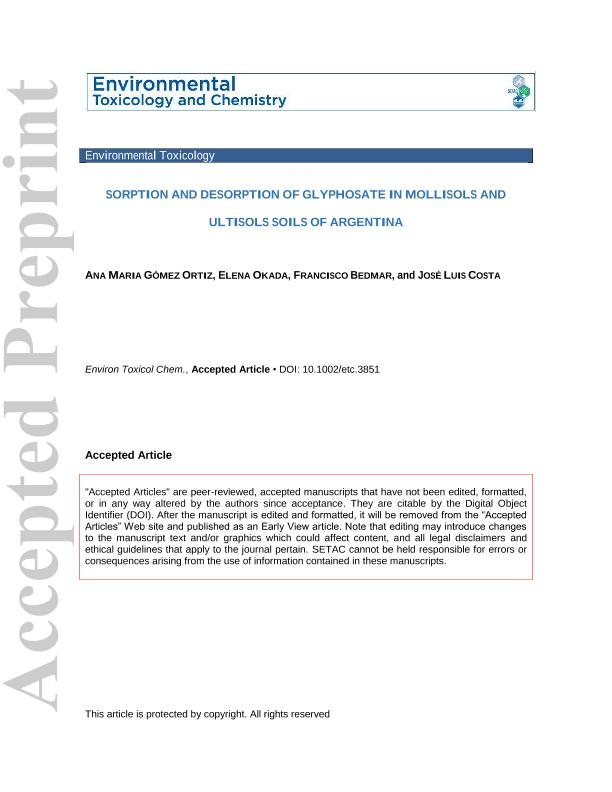Mostrar el registro sencillo del ítem
dc.contributor.author
Gómez Ortiz, Ana Maria

dc.contributor.author
Okada, Elena

dc.contributor.author
Bedmar, Francisco

dc.contributor.author
Costa, Jose Luis

dc.date.available
2017-12-19T19:40:09Z
dc.date.issued
2017-05
dc.identifier.citation
Costa, Jose Luis; Bedmar, Francisco; Okada, Elena; Gómez Ortiz, Ana Maria; Sorption and desorption of glyphosate in Mollisols and Ultisols soils of Argentina; Society of Environmental Toxicology and Chemistry; Environmental Toxicology and Chemistry; 36; 10; 5-2017; 2587-2592
dc.identifier.issn
0730-7268
dc.identifier.uri
http://hdl.handle.net/11336/31055
dc.description.abstract
In Argentina, glyphosate use has increased exponentially in the past years due to the widespread adoption of no-till management combined with genetically modified glyphosate-resistant crops. This massive use of glyphosate has created concern about its potential environmental impact. Sorption-desorption of glyphosate was studied in three Argentinean soils with contrasting characteristics. Glyphosate sorption isotherms were modeled using the Freundlich equation to estimate the sorption coefficient (Kf). Glyphosate sorption was high and the Kf varied from 115.6 to 1612 mg 1-1/nL1/n /Kg. Cerro Azul soil had the highest glyphosate sorption capacity due to a combination of factors such as higher clay content, CEC, total Fe, Al oxides and lower available phosphorous and pH. Desorption isotherms were also modeled using the Freundlich equation. In general, desorption was very low (<12%). The low values of hysteresis coefficient (H) confirm that glyphosate strongly sorbs to the soils and that it is almost an irreversible process. Anguil soil had a significant higher desorption coefficient (Kfd) than the other soils, associated with its lower clay content and higher pH and phosphorous. Glyphosate high sorption and low desorption to the studied soils may prevent groundwater contamination. However, it may also affect its bioavailability increasing its persistence and favoring its accumulation in environment. Results of this study contribute to the knowledge and characterization of glyphosate retention in different soils.
dc.format
application/pdf
dc.language.iso
eng
dc.publisher
Society of Environmental Toxicology and Chemistry

dc.rights
info:eu-repo/semantics/embargoedAccess
dc.rights.uri
https://creativecommons.org/licenses/by-nc-sa/2.5/ar/
dc.subject
Sorption
dc.subject
Desorption
dc.subject
Glyphosate
dc.subject
Soil Properties
dc.subject.classification
Meteorología y Ciencias Atmosféricas

dc.subject.classification
Ciencias de la Tierra y relacionadas con el Medio Ambiente

dc.subject.classification
CIENCIAS NATURALES Y EXACTAS

dc.title
Sorption and desorption of glyphosate in Mollisols and Ultisols soils of Argentina
dc.type
info:eu-repo/semantics/article
dc.type
info:ar-repo/semantics/artículo
dc.type
info:eu-repo/semantics/publishedVersion
dc.date.updated
2017-12-12T19:44:47Z
dc.journal.volume
36
dc.journal.number
10
dc.journal.pagination
2587-2592
dc.journal.pais
Estados Unidos

dc.description.fil
Fil: Gómez Ortiz, Ana Maria. Universidad Nacional de Mar del Plata; Argentina
dc.description.fil
Fil: Okada, Elena. Consejo Nacional de Investigaciones Científicas y Técnicas; Argentina. Instituto Nacional de Tecnología Agropecuaria; Argentina
dc.description.fil
Fil: Bedmar, Francisco. Universidad Nacional de Mar del Plata; Argentina
dc.description.fil
Fil: Costa, Jose Luis. Instituto Nacional de Tecnología Agropecuaria; Argentina
dc.journal.title
Environmental Toxicology and Chemistry

dc.rights.embargoDate
2018-05-01
dc.relation.alternativeid
info:eu-repo/semantics/altIdentifier/url/http://doi.wiley.com/10.1002/etc.3851
dc.relation.alternativeid
info:eu-repo/semantics/altIdentifier/doi/http://dx.doi.org/10.1002/etc.3851
Archivos asociados
